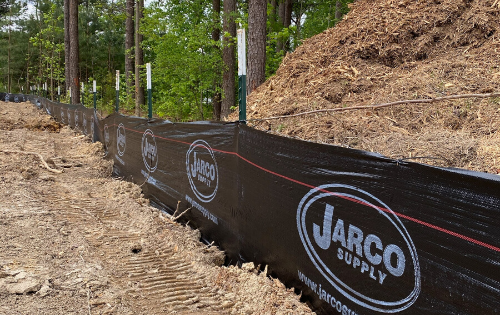Excellence with Memphis Erosion Control Solutions hydroseeding
Wiki Article
Ideal Practices for Erosion Control in Construction Projects
Are you dealing with a construction job and concerned about erosion control? Look no more! In this post, we will certainly guide you with the very best techniques for protecting against erosion on your website. You'll find five essential techniques, effective sediment and overflow administration strategies, crucial factors to consider for slope stablizing, and suggestions for safeguarding vegetation and dirt. We'll also look into the significance of carrying out appropriate water drainage systems. Get all set to deal with erosion head-on and guarantee the success of your building project.5 Essential Disintegration Control Strategies

To successfully regulate erosion on your building and construction site, you'll need to execute necessary methods such as incline stablizing and debris control procedures. Incline stablizing is essential in preventing dirt disintegration on high slopes. Another effective strategy is the use of disintegration control blankets or mats, which are put on the slope and help keep dirt bits while enabling vegetation to grow.
Effective Sediment and Overflow Monitoring
You can properly handle sediment and runoff in your building and construction project by carrying out appropriate disintegration control actions. One more essential practice is the execution of disintegration control blankets or mats. By executing these disintegration control procedures, you can properly take care of debris and runoff in your building and construction job, lessening the effect on the atmosphere and abiding with governing requirements.
Key Considerations for Incline Stablizing
When considering incline stablizing, it's important to examine the terrain and recognize prospective locations of instability. You require to thoroughly examine the incline's qualities, such as its structure, drainage, and angle patterns. Try to find indications of disintegration, such as exposed roots, fractures, or down dirt. These indicators can provide you an idea of where stabilization measures might be essential.One more alternative is to plant greenery on the slope, as the origins can help secure the dirt and control disintegration. Furthermore, setting up erosion control blankets or floor coverings can give instant security while greenery comes to be established.
It's crucial to consistently keep track of the stabilized inclines to ensure their efficiency. Watch out for any type of indicators of activity or disintegration, and take prompt activity if needed. Regular upkeep, such as examining and repairing any damaged procedures, is additionally necessary to make sure lasting stability.
Finest Practices for Plant Life and Soil Security
One reliable method to shield vegetation and dirt on slopes is by on a regular basis inspecting for indications of erosion and taking instant activity if necessary. By being watchful and proactive, you can prevent further damages and make certain the security of the slope. Beginning by examining the incline for any type of indicators of disintegration, such as exposed roots, bare soil patches, or sediment accumulation near the bottom. It is critical to resolve the concern without delay if you see any of these signs. Implement disintegration control measures such as mounting disintegration control blankets, mulching, and even creating natural stone retaining wall keeping wall surfaces if needed. Additionally, planting greenery can dramatically aid in maintaining the dirt. Select native plants that have deep root systems, as they are a lot more effective in stopping disintegration. Make certain to regularly assess the health of the vegetation and provide essential foundation planting plans upkeep, like watering and fertilizing. Bear in mind, disintegration can swiftly intensify and create severe damages, so it's vital to address it as quickly as feasible. By taking proactive measures and frequently monitoring the incline, you can protect the greenery and dirt, making sure the long-lasting stability of the location.Implementing Correct Drain Solutions
When it comes to managing water flow and avoiding erosion, comprehending these aspects is important. Steeper slopes can lead to quicker water flow, boosting the risk of disintegration and flooding. On the various other hand, gentler slopes permit water to stream a lot more gradually, decreasing erosion potential.Dirt kind likewise affects water drainage system design. Different dirt kinds have differing levels of leaks in the structure, impacting how water is taken in and drained. For example, sandy soils have a tendency to drain pipes faster due to their coarse texture, while clay dirts have a slower drain rate due to their compact nature. Recognizing the soil type helps in picking appropriate drainage techniques, such as utilizing absorptive materials or look these up setting up French drains. Additionally, taking into consideration the soil qualities helps stop waterlogging, which can cause bad plant development and damages to frameworks.
Verdict
To conclude, when it concerns disintegration control in building tasks, you need to comply with these finest methods. Execute effective sediment and drainage monitoring techniques to stop air pollution. Take into consideration incline stabilization techniques to ensure the stability of the site. Protect plants and dirt by utilizing ideal measures. Develop appropriate water drainage systems to manage water circulation (Memphis Erosion Control Solutions excavation). By complying with these vital methods, you can effectively control disintegration and guarantee the success of your construction job.To efficiently control disintegration on your building website, you'll require to apply necessary strategies such as incline stablizing and debris control actions. Slope stabilization is crucial in avoiding soil erosion on high inclines. An additional effective technique is the use of disintegration control coverings or floor coverings, which are positioned on the incline and help keep dirt particles while enabling vegetation to grow. Another alternative is to plant plants on the incline, as the roots can assist anchor the dirt and control disintegration. Implement erosion control procedures such as mounting disintegration control blankets, mulching, or even creating preserving walls if needed.
Report this wiki page